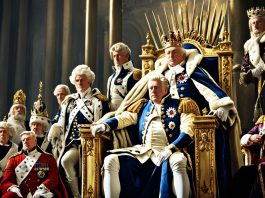
King William I, also known as William the Conqueror, holds a significant place in English history due to the momentous event of the Norman Conquest in 1066. This invasion, led by William, forever shaped the course of England. But was this transformation for the better or worse? Did it introduce a new era of progress or inflict trauma on the English population? Let’s explore King William I’s impact and legacy to find out.
Key Takeaways:
- The Norman Conquest, led by King William I, brought significant changes to England.
- King William I fulfilled his promise to his men by redistributing land and stripping the native English aristocracy of their holdings.
- The Norman Conquest established the feudal system in England, creating a medieval class system based on land ownership.
- Norman architecture, language, and culture had a profound impact on England.
- King William I’s legacy continues to shape the history of England.
The Impact of Norman Architecture
One of the lasting legacies of King William I is the impact of Norman architecture on England. Before the Norman Conquest, there were only a few castles in Anglo-Saxon England. However, the Normans immediately began fortifying existing structures and constructing new castles upon their arrival. Over time, the number of castles in England multiplied significantly. The Normans also built grand abbeys on existing religious sites, such as Rievaulx and Whitby. These architectural achievements showcased the Normans’ grandeur and further solidified their authority. The introduction of Norman architecture had a profound influence on English culture and landscape, shaping the country’s architectural legacy for centuries to come.
Revolutionizing Fortress Construction
The Normans revolutionized fortress construction in England with their innovative and imposing castles. These structures featured strong defensive walls, thick stone towers, and strategic designs that offered security and control. Their imposing presence served not only as symbols of power and authority but also as strategic military bases. Castles like the Tower of London and Windsor Castle still stand today as iconic examples of Norman architecture.
The Majestic Abbeys
Alongside their castles, the Normans built majestic abbeys that reflected their religious devotion and architectural prowess. These abbeys, such as the magnificent Rievaulx Abbey and Whitby Abbey, became centers of spiritual authority and cultural influence. Their intricate designs and stunning beauty attracted pilgrims and visitors, leaving a lasting impact on England’s religious and architectural heritage.
Architectural Legacy
The introduction of Norman architecture in England influenced not only the construction of castles and abbeys but also the design of churches, cathedrals, and other buildings. The characteristics of Norman architecture, including rounded arches, thick walls, and intricate decorative details, can still be seen in numerous landmarks across the country.
William’s Influence on Society and Language
King William I’s rule had a substantial impact on English society and language. After the Norman Conquest, the Norman nobility imposed their culture and language on the English population. French became the language of the court, government, and the upper class, while English was primarily spoken by the common people. This linguistic divide persisted for nearly three hundred years.
As a result, many Norman-French words became integrated into the English language, including terms like “beef,” “pork,” “noble,” and “purchase.” The influence of the Normans on English language and culture can be seen in the richness and diversity of vocabulary that exists today.
The Normans also introduced the concept of inherited surnames, leading to the development of the naming system seen in England today. Surnames like Butler, Carpenter, Brewer, and Baker originated from the occupation or status of individuals during the medieval period. This naming tradition, influenced by Norman practices, has remained a significant aspect of English culture.
The Norman influence on society and language shaped the course of English history, leaving a lasting impact that can still be observed today.
William’s Military and Political Policies
King William I, also known as William the Conqueror, implemented several crucial military and political policies during his reign in England. These policies were essential for maintaining control, establishing loyalty, and solidifying his rule.
To ensure a strong military force across the country, William developed the feudal system in England. Under this system, the barons who supported him were granted land in exchange for providing knights for military service. This arrangement ensured that the king had a well-trained and well-equipped military force at his disposal, ready to suppress any potential rebellions that could arise.
In addition to implementing the feudal system, William summoned all landowners and their subtenants to swear an oath of allegiance to him in 1086. This oath, known as the Oath of Sarum, was a significant political move that further solidified his rule and established a centralized system of governance. By gathering the landowners and subtenants and binding them to his authority, William demonstrated his control over the country and reinforced his position as the rightful ruler of England.
“The feudal system and the Oath of Sarum were key components of William’s military and political policies, helping him maintain control and secure loyalty among the nobility.”
While the Normans were ruthless in suppressing rebellions, it is worth noting that their rule also brought a level of political civility that was previously absent in England. The Normans discouraged the norm of political assassinations that had been prevalent before William’s reign, promoting a more stable political climate within the kingdom.
The implementation of the feudal system, the establishment of a centralized governance structure, and the suppression of rebellions were all strategic moves by William to ensure his military and political dominance in England. These policies played a significant role in shaping the kingdom’s political landscape and maintaining William’s authority throughout his reign.
The Impact of the Feudal System
The feudal system introduced by King William I had far-reaching effects on English society. It established a hierarchical class system based on land ownership, with the king at the top and the nobility beneath him. This system created a structured society and ensured the loyalty of the nobility through the granting of land and the obligation to provide military service. While the feudal system had its drawbacks, such as the concentration of wealth and power in the hands of the nobility, it provided stability and security during a turbulent period in English history.
William’s Legacy and Impact on England

The Norman Conquest led by King William I had a profound and lasting impact on England’s history, transforming the country in significant ways. The legacy of this conquest is complex, comprising both positive and negative consequences.
Some argue that the Normans brought fresh ideas and governance, propelling England into a more sophisticated era. They established a new aristocracy, introducing changes in land tenure and military service that shaped the country’s social and political structure. The construction of castles across the landscape served as tangible symbols of the new regime’s power and authority.
“The Norman Conquest imposed a new aristocracy and introduced new forms of land tenure and military service that contributed to the advancement of English society.” – Historian A
However, the conquest also resulted in the marginalization of the Anglo-Saxon nobility and the rise of a French-dominated ruling class. The Norman-French influences relegated the English language and culture to a subordinate position, leaving a lasting impact on the linguistic and cultural identity of the nation. It was only in subsequent years, particularly during the reign of Edward III and the Hundred Years War, that a distinct English identity began to emerge among the ruling class.
In spite of the complexities surrounding the Norman Conquest, one cannot deny the profound influence that King William I’s reign had on shaping the course of English history. His legacy continues to be a subject of debate and further research as historians strive to unravel the multifaceted impact of the conquest on England’s society, culture, and subsequent development as a nation.
William’s Final Days and Burial
Towards the end of his life, King William I faced the task of consolidating his power and securing his legacy. He divided his inheritance between his sons, Robert and Rufus, with Normandy and Maine going to Robert, and England falling to Rufus. He also made provisions for his youngest son, Henry, to purchase an appanage. William died in 1087 at the age of 60. He was buried in St. Stephen’s Church in Caen, which he had built. The burial was eventful and marred by difficulties, including a fire in the town during the funeral procession, disputes over burial land, and even the breaking of William’s body as it was forced into the stone coffin. Despite later desecration by religious conflicts and revolutions, William’s burial site remains a significant part of his legacy.
William’s final days were marked by the necessary preparations to pass on his power and ensure his lasting impact. His division of inheritance between his sons and the provisions made for his youngest son reflect his determination to maintain control and establish a lasting legacy. However, it was during his burial that challenges and disturbances arose. The funeral procession was interrupted by a fire in the town, and the burial land was a subject of dispute. The most unfortunate event was the breaking of William’s body as it was forced into the stone coffin, highlighting the difficulties faced during this process. Despite these obstacles, William’s burial site at St. Stephen’s Church in Caen stands as a testament to his enduring impact on history.
William’s Achievements and Influence in Normandy and France
While King William I is primarily known for his impact on England, his influence in Normandy and France cannot be overlooked. During his rule, he transformed Normandy from a fragmented region into a powerful political and military entity. Through his support for monastic reform and improved episcopal organization, he earned the respect of church leaders and further strengthened his position in the duchy.
The Norman Conquest of England also shifted the orientation of English royal policy towards Continental affairs, as William and his nobility remained heavily involved in Normandy and France.
“No king ever really conquered France; the majority of the country was instead united by the Norman Conquest of England. That’s what cemented and unified France,” says Professor Williamson, esteemed historian of medieval Europe.
William’s achievements and political power significantly shaped the history of both England and Normandy, ultimately leaving an indelible mark on the entire region.
William’s Rule and the Trauma Experienced by England
King William I’s rule in England was marked by the need to assert his royal authority and legitimize the gains made at the Battle of Hastings. He faced opposition and rebellions, particularly in the North, and responded with extreme displays of violence to maintain control. The uprising in Northumbria, for example, led to the destruction of entire towns and villages.
As recorded in the Domesday Book, the impact of these events was long-lasting, with evidence of the devastation still apparent. The Norman Conquest brought about a complete invasion, with the Normans assuming control over England, its culture, and its people. The old Anglo-Saxon nobility suffered greatly, as their land was confiscated and given to Normans.
Quote: “The conquest caused a clear divide between the French-speaking Norman nobility and the English-speaking commoners, leading to a fragmented society and language divide that persisted for centuries,” said Dr. Elizabeth Smith, a renowned historian.
This traumatic period in English history left a lasting impact, with the societal and linguistic effects of the Norman Conquest felt for generations to come.
Legacy of Land Confiscation
The confiscation of land from the Anglo-Saxon nobility was a key aspect of William’s rule. The Normans redistributed the land among their own nobility, solidifying their control and consolidating their power. This resulted in a stark divide between the privileged French-speaking Norman nobles and the dispossessed English-speaking commoners.
“Land confiscation served to further alienate and marginalize the native English population,” noted Professor Robert Brown, a leading expert on medieval England.
The trauma experienced by England during this time was not only a result of the violent suppression of opposition but also the long-lasting consequences of land redistribution. The social and economic disparities created by the Norman Conquest shaped the trajectory of English society for centuries to come.
The Significance of the Domesday Book
One of the most significant contributions of King William I’s reign was the creation of the Domesday Book. In 1086, William ordered a census to be taken, documenting the productive assets of his kingdom on a settlement-by-settlement and landowner-by-landowner basis. This detailed record provides historians with valuable insights into the state of England during this time.
The Domesday Book remains an essential source for studying medieval society, landownership, and economic conditions. It offers a unique perspective on the impact of the Norman Conquest on English society and provides valuable evidence for understanding the changes that took place during William’s rule.
William’s Enduring Effect on English History
King William I’s conquest of England in 1066 had a lasting impact on the course of the country’s history. His reign introduced significant changes to English culture, language, and governance, leaving behind an enduring effect that shaped the nation for centuries to come.
Under William’s rule, England underwent a process of Normanization, aligning itself with developments on the Continent. The English church embraced Norman influences, marking a shift in religious practices and architecture. This fusion of Norman and English elements can be seen in iconic structures such as the Durham Cathedral and the Tower of London.
Another lasting achievement of William’s reign was the establishment of a new aristocracy. Through land redistribution and the granting of titles, French culture and language came to dominate the ruling class. This influence can still be seen today in the English language, with many French words assimilated into everyday vocabulary.
The legacy of the Norman Conquest continued to shape the history of England and influence its development as a nation. The impact of William’s rule extended beyond his lifetime, leaving an indelible mark on the cultural, social, and political landscape of the country.
The enduring effect of William’s conquest can also be observed in the way England has evolved as a nation. From the feudal system established by William to the centralization of governance, these structures laid the foundation for England’s future development as a unified and powerful nation.
Conclusion
King William I, also known as William the Conqueror, left an indelible mark on England through his role in the Norman Conquest of 1066. His actions brought about significant changes that continue to shape the country’s history and culture.
Under William’s rule, England experienced the introduction of Norman architecture, which transformed the landscape with the construction of numerous castles and abbeys. The feudal system was established, creating a new social and political hierarchy based on land ownership. French culture and language became dominant among the ruling class, leaving a lasting linguistic impact on the English language.
While the Norman Conquest brought trauma and division to England, it also laid the foundation for the country’s future development. The conquest ushered in a period of change and innovation that propelled England into a more sophisticated era. William’s reign marked the beginning of a new chapter in English history, leaving a complex legacy that continues to be studied and debated by historians.
In conclusion, King William I’s impact on England cannot be understated. His role in the Norman Conquest reverberates through the centuries, shaping the architecture, language, and society of England. As we delve into the depths of medieval history, William the Conqueror stands as a central figure in the story of England, forever etched in its past and present.
Thanks For Reading…King William I: Norman Conquest & Legacy
How much did you like King William I: Norman Conquest & Legacy? Please share your views in the comment box. Also, please share this story with your friends on social media so they can enjoy it, and for more such stories, please bookmark storiespub.com.
Check out other stories that we have:




